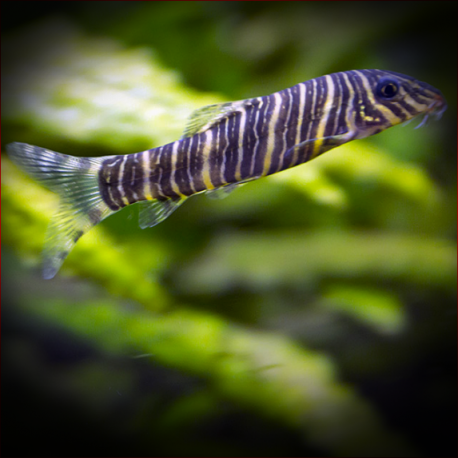More info
Datasheet
| Minimum Tank Size | 160 litres / 42.27 US gallons |
| Maximum Size | 9.0cm / 3.54inches |
| Temperature | 21°C / 69.80°F - 26°C / 78.80°F |
| Hardness | 1.01dgH / 18ppm - 10.03dgH / 179ppm |
| pH | 6.0-7.5 |
General Description
The Botia Striata, commonly known as the Zebra Loach, is a peaceful species belonging to the family Botiidae within the classification order of Cypriniformes. It is distinguished by its yellow to golden base coloration with 7-9 blue, green, grey, or black body bars, often accompanied by red mouthparts. This species typically reaches a maximum size of 9.0cm and is recognized for its peaceful nature, making it a suitable choice for community aquariums.
Aquarium Setup
When setting up an aquarium for Botia Striata, a well-structured environment is essential. Substrate options include sand or fine gravel, complemented by smooth rocks, pebbles, driftwood, and branches. Providing adequate hiding spots and cover is important, as these loaches are inquisitive and enjoy exploring their surroundings. It is advisable to avoid sharp-edged decor and ensure any gaps are sealed to prevent entrapment. Maintaining well-oxygenated water with slight flow and pristine conditions is crucial for the species' thriving. Regular water changes of 30-50% tank volume are recommended to uphold water quality.
Behavior
Zebra Loaches exhibit peaceful behavior; however, caution must be exercised when selecting tankmates, as smaller fish may feel intimidated by their size and activity. They are known to form complex social hierarchies and thrive in groups of at least 5-6 specimens. Individual Zebra Loaches can become withdrawn or aggressive if kept singly, emphasizing the importance of group dynamics in their social interactions. These loaches showcase unique behaviors such as "greying out" during dominance battles and "shadowing," where younger individuals mimic older ones' movements.
Feeding and Diet
Although predominantly carnivorous, Botia Striata will also consume vegetative matter if available. Their diet should consist of varied foods, including quality dried products, live or frozen fare like bloodworms and Artemia, and fresh vegetables such as cucumber and spinach. Homemade gelatin-bound foods and chopped earthworms can also be beneficial. It is notable that Botia Striata should not be solely relied upon for snail control, as they are not obligate molluscivores.
Reproduction & Dimorphism
The breeding of Botia Striata in captivity remains uncommon, with commercial breeding practices reliant on hormone-induced spawning. Sexual dimorphism is observable through plumper females, indicating egg development. However, instances of hybridization, including crosses between B. histrionica and Chromobotia macracanthus, have been reported due to commercial breeding practices.
Habitat and Distribution
Found in the Tunga River in Karnataka, southern India, Botia Striata inhabits areas with temperatures around 21-26°C and a pH of 6.0-7.5. The species coexists with various other fish species, such as Puntius chola and Mystus armatus. In the wild, these loaches prefer environments with a mix of substrates, including bedrock, cobbles, gravel, and leaf litter, and are commonly observed downstream of dams forming reservoirs.
Distribution
Botia Striata's distribution extends within the Krishna River drainage in India, with recorded sightings in tributaries like the Koyna and Panchganga rivers. The Western Ghats mountain range serves as the species' natural habitat, before the river network flows eastwards through multiple states and eventually empties into the Bay of Bengal.

